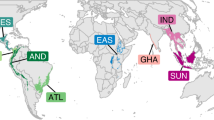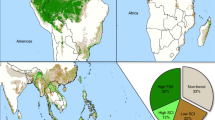Abstract
The rapid disruption of tropical forests probably imperils global biodiversity more than any other contemporary phenomenon1,2,3. With deforestation advancing quickly, protected areas are increasingly becoming final refuges for threatened species and natural ecosystem processes. However, many protected areas in the tropics are themselves vulnerable to human encroachment and other environmental stresses4,5,6,7,8,9. As pressures mount, it is vital to know whether existing reserves can sustain their biodiversity. A critical constraint in addressing this question has been that data describing a broad array of biodiversity groups have been unavailable for a sufficiently large and representative sample of reserves. Here we present a uniquely comprehensive data set on changes over the past 20 to 30 years in 31 functional groups of species and 21 potential drivers of environmental change, for 60 protected areas stratified across the world’s major tropical regions. Our analysis reveals great variation in reserve ‘health’: about half of all reserves have been effective or performed passably, but the rest are experiencing an erosion of biodiversity that is often alarmingly widespread taxonomically and functionally. Habitat disruption, hunting and forest-product exploitation were the strongest predictors of declining reserve health. Crucially, environmental changes immediately outside reserves seemed nearly as important as those inside in determining their ecological fate, with changes inside reserves strongly mirroring those occurring around them. These findings suggest that tropical protected areas are often intimately linked ecologically to their surrounding habitats, and that a failure to stem broad-scale loss and degradation of such habitats could sharply increase the likelihood of serious biodiversity declines.
This is a preview of subscription content, access via your institution
Access options
Subscribe to this journal
Receive 51 print issues and online access
$199.00 per year
only $3.90 per issue
Buy this article
- Purchase on Springer Link
- Instant access to full article PDF
Prices may be subject to local taxes which are calculated during checkout





Similar content being viewed by others
Change history
12 September 2012
Axis labelling in Fig. 1 and a typo in the Fig. 2 legend were corrected.
References
Pimm, S. L. & Raven, P. R. Biodiversity: extinction by numbers. Nature 403, 843–845 (2000)
Bradshaw, C. J. A., Sodhi, N. S. & Brook, B. W. Tropical turmoil—a biodiversity tragedy in progress. Front. Ecol. Environ 7, 79–87 (2009)
Gibson, L. et al. Primary forests are irreplaceable for sustaining tropical biodiversity. Nature 478, 378–381 (2011)
Bruner, A. G., Gullison, R., Rice, R. & da Fonseca, G. Effectiveness of parks in protecting tropical biodiversity. Science 291, 125–128 (2001)
Curran, L. M. et al. Lowland forest loss in protected areas of Indonesian Borneo. Science 303, 1000–1003 (2004)
DeFries, R., Hansen, A., Newton, A. C. & Hansen, M. C. Increasing isolation of protected areas in tropical forests over the past twenty years. Ecol. Appl. 15, 19–26 (2005)
Lovejoy, T. E. Protected areas: A prism for a changing world. Trends Ecol. Evol. 21, 329–333 (2006)
Possingham, H. P., Wilson, K. A., Andelman, S. J. & Vynne, C. H. in Principles of Conservation Biology (eds Groom, M. J., Meffe, G. K. & Carroll, C. R. ) (Sinauer, 2006)
Joppa, L. N., Loarie, S. & Pimm, S. L. On the protection of “protected areas”. Proc. Natl Acad. Sci. USA 105, 6673–6678 (2008)
Jenkins, C. N. & Joppa, L. Expansion of the global terrestrial protected area system. Biol. Conserv. 142, 2166–2174 (2009)
Asner, G. P. et al. Selective logging in the Brazilian Amazon. Science 310, 480–482 (2005)
Wright, S. J., Sanchez-Azofeifa, G., Portillo-Quintero, C. & Davies, D. Poverty and corruption compromise tropical forest reserves. Ecol. Appl. 17, 1259–1266 (2007)
Adeney, J. M., Christensen, N. & Pimm, S. L. Reserves protect against deforestation fires in the Amazon. PLoS ONE 4, e5014 (2009)
Peres, C. A., Barlow, J. & Laurance, W. F. Detecting anthropogenic disturbance in tropical forests. Trends Ecol. Evol. 21, 227–229 (2006)
Hansen, A. J. & DeFries, R. Ecological mechanisms linking protected areas to surrounding lands. Ecol. Appl. 17, 974–988 (2007)
Laurance, W. F. et al. Biomass collapse in Amazonian forest fragments. Science 278, 1117–1118 (1997)
Woodroffe, R. & Ginsberg, J. R. Edge effects and the extinction of populations inside protected areas. Science 280, 2126–2128 (1998)
Terborgh, J. et al. Ecological meltdown in predator-free forest fragments. Science 294, 1923–1926 (2001)
Laurance, W. F. et al. The fate of Amazonian forest fragments: a 32-year investigation. Biol. Conserv. 144, 56–67 (2011)
Brooks, T. M., Pimm, S. L. & Oyugi, J. O. Time lag between deforestation and bird extinction in tropical forest fragments. Conserv. Biol. 13, 1140–1150 (1999)
Peres, C. A. Why we need megareserves in Amazonia. Conserv. Biol. 19, 728–733 (2005)
Maiorano, L., Falcucci, A. & Boitani, L. Size-dependent resistance of protected areas to land-use change. Proc. R. Soc. B 275, 1297–1304 (2008)
Estes, J. A. et al. Trophic downgrading of Planet Earth. Science 333, 301–306 (2011)
Wells, M. P. & McShane, T. O. Integrating protected area management with local needs and aspirations. Ambio 33, 513–519 (2004)
Scherl, L. M. et al. Can Protected Areas Contribute to Poverty Reduction? Opportunities and Limitations (IUCN, 2004)
Chan, K. M. A. & Daily, G. C. The payoff of conservation investments in tropical countryside. Proc. Natl Acad. Sci. USA 105, 19342–19347 (2008)
Porter-Bolland, L. et al. Community-managed forests and protected areas: an assessment of their conservation effectiveness across the tropics. For. Ecol. Manage. 256, 6–17 (2012)
Thomas, C. D. et al. Extinction risk from climate change. Nature 427, 145–148 (2004)
Sekercioglu, C. H., Schneider, S. H., Fay, J. P. & Loarie, S. R. Climate change, elevational range shifts, and bird extinctions. Conserv. Biol. 22, 140–150 (2008)
Shoo, L. P. et al. Targeted protection and restoration to conserve tropical biodiversity in a warming world. Glob. Change Biol. 17, 186–193 (2011)
Acknowledgements
The study was supported by James Cook University, the Smithsonian Tropical Research Institute, an Australian Laureate Fellowship (to W.F.L.) and NSF grant RCN-0741956. We thank A. Bruner, R. A. Butler, G. R. Clements, R. Condit, C. N. Cook, S. Goosem, J. Geldmann, L. Joppa, S. L. Pimm and O. Venter for comments.
Author information
Authors and Affiliations
Contributions
W.F.L. conceived the study and coordinated its design, analysis and manuscript preparation. D.C.U., J.R. and M.K. conducted the interviews; C.J.A.B. assisted with data analysis and some writing; and S.P.S., S.G.L., M.C. and W.L. organized data or collected metadata. The remaining authors provided detailed interviews on protected areas and offered feedback on the manuscript.
Corresponding author
Ethics declarations
Competing interests
The authors declare no competing financial interests.
Supplementary information
Supplementary Information
This file contains Supplementary Figures 1-6, Supplementary Text and Data, Supplementary Tables 1-6, additional references and a Supplementary Appendix, which comprises a non-interactive copy of an expert questionnaire. (PDF 2171 kb)
Rights and permissions
About this article
Cite this article
Laurance, W., Carolina Useche, D., Rendeiro, J. et al. Averting biodiversity collapse in tropical forest protected areas. Nature 489, 290–294 (2012). https://doi.org/10.1038/nature11318
Received:
Accepted:
Published:
Issue Date:
DOI: https://doi.org/10.1038/nature11318
This article is cited by
-
Deforestation poses deleterious effects to tree-climbing species under climate change
Nature Climate Change (2024)
-
Risk of introduction and establishment of alien vertebrate species in transboundary neighboring areas
Nature Communications (2024)
-
FSC-certified forest management benefits large mammals compared to non-FSC
Nature (2024)
-
Mammal recovery inside and outside terrestrial protected areas
Ambio (2024)
-
Temporal changes in the taxonomic and functional structure of bryophyte assemblages warn about the conservation status of biological refuges
Biodiversity and Conservation (2024)
Comments
By submitting a comment you agree to abide by our Terms and Community Guidelines. If you find something abusive or that does not comply with our terms or guidelines please flag it as inappropriate.



